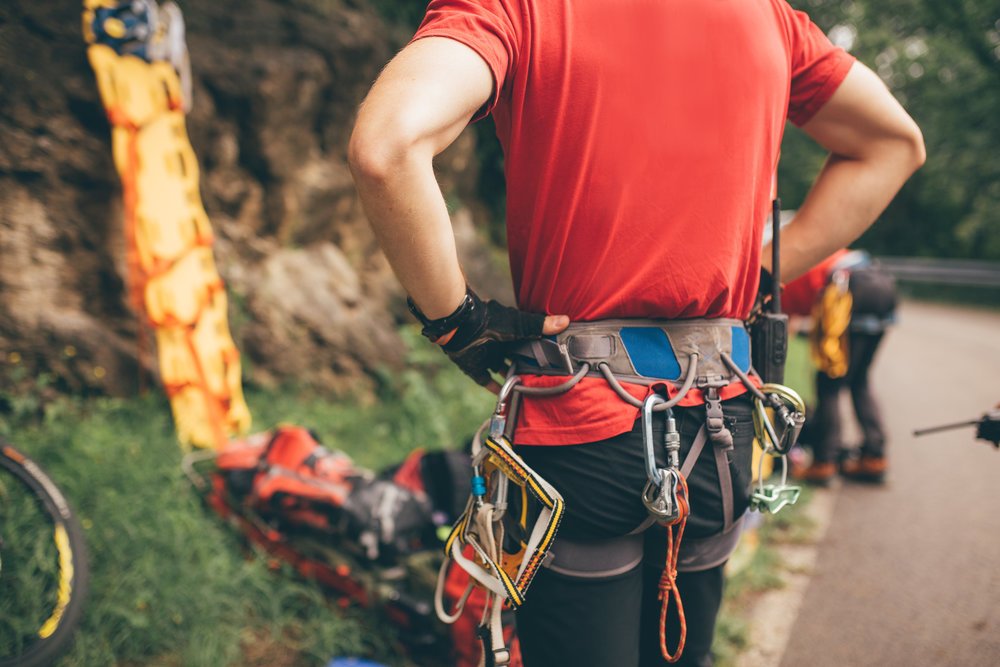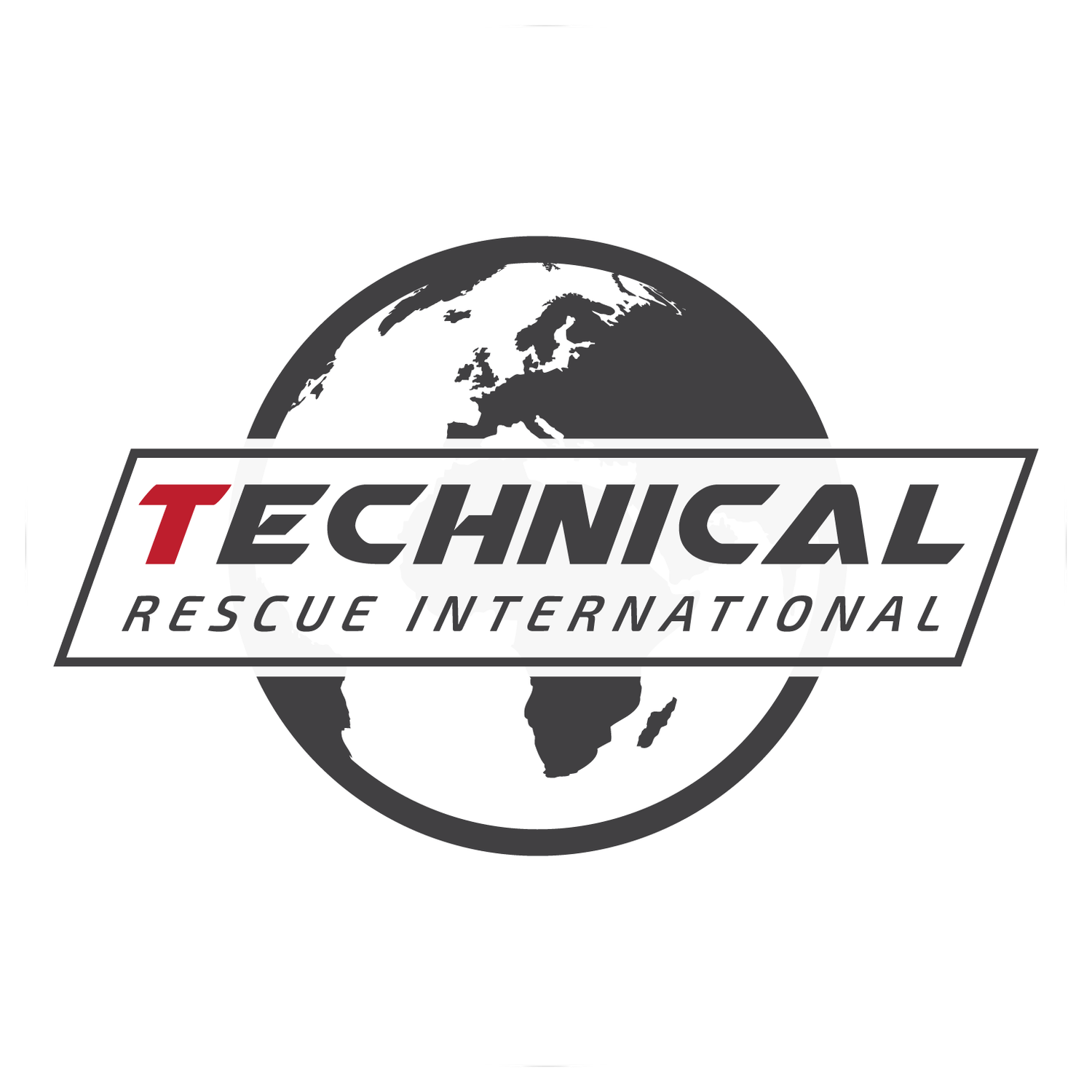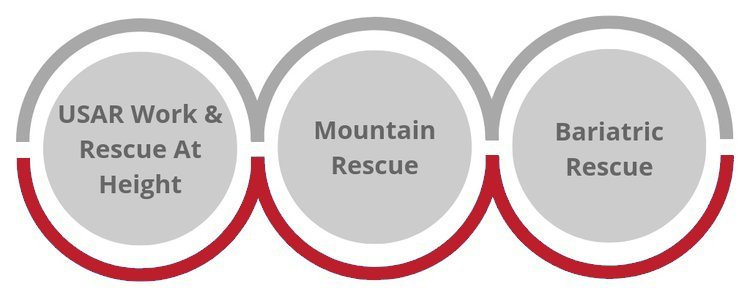
Working At Height Training
Technical Rescue International’s provision of training for Work and Rescue at Height is second to none. The Technical Rescue International Work and Rescue at Height programme is progressive and includes courses for most Work and Rescue at Height sectors along with some very specific courses unique to Technical Rescue International. The Instructors that deliver the courses are all extremely experienced in a number of Work and Rescue at Height Sectors and have been delivering training for many years. All Instructors are current/operational in their specific sector of work.
Our working at height training programme is divided into 8 modules.
Working At Height Programme Modules 1-5
Working At Height Programme Modules 6-8
Safe Working at Height
This course is aimed at industrial and emergency services operatives who require to work at height in their day to day activities. The course takes the delegate through legal and legislative requirements, theory and practical skills to enable them to recognise when a safe system of work has to be implemented, how to create the system and what to do if rescue of a worker is required.
-
The aim of this course is to provide the skills, knowledge and understanding to enable delegates to become qualified in Safe Working at Height operations.
-
Successful completion of the course will enable delegates to fulfil the following outcomes according to current legislation, regulations and recognised standards;
Describe the SWAH capability, associated hazards, Safe System of Work, sequence of activities, responsibilities and legislative requirements
Correctly identify all items of equipment issued for the purpose of safe work at height and rescue
Describe design, use, advantages, disadvantages, limitations and safety aspects of working at height equipment
Describe and demonstrate how to inspect, don, use SWAH PPE and associated equipment
Demonstrate how to tie knots suitable for working at height
Select appropriate anchors and construct anchor systems
State and demonstrate how equipment can be protected from sharp or abrasive edges
State the definition of the different systems of work and demonstrate each type
Describe situations likely to cause suspension syncope and measures to mitigate
Demonstrate the use of a temporary horizontal lifeline
Demonstrate a rescue and recovery using a reach pole rescue pack
Describe and demonstrate systems set-up to take into account of emergency evacuation
-
2 Days
Rope Rescue 1
This course is aimed at industrial and emergency services operatives who require the ability to rescue a casualty from height utilising a rescue sling or a stretcher. The course leads delegates through a structured and safe approach to rescue enabling them to create safe systems of work to access the casualty, then lower or raise them to a place of safety.
-
The aim of this course is to provide the skills, knowledge and understanding to enable delegates to become qualified in basic rope rescue operations.
-
Successful completion of the course will enable delegates to fulfil the following outcomes according to current legislation, regulations and recognised standards;
Describe a rope rescue capability, associated hazards, Safe System of Work, sequence of activities, responsibilities and legislative requirements
Correctly identify all items of equipment issued for the purpose of rope rescue
Describe design, use, advantages, disadvantages, limitations and safety aspects of rope rescue equipment
Describe and demonstrate how to inspect and use rope rescue and associated equipment
Demonstrate how to tie knots suitable for rope rescue
Select appropriate anchors and construct anchor systems
State and demonstrate how equipment can be protected from sharp or abrasive edges
State the definition of the different systems of work and demonstrate each type
Demonstrate how to abseil and ascend ropes
Demonstrate a pick-off rescue
Demonstrate rescue using a stretcher on a vertical system
Demonstrate how to rig a stretcher to move from a horizontal to a vertical plane
Demonstrate how to negotiate a difficult edge with a stretcher
Demonstrate systems set-up to take into account of emergency evacuation.
-
5 Days
Rope Rescue 2
This course is aimed at industrial and emergency services operatives who require the ability to rescue a casualty from height in complex situations or structures utilising a rescue sling or a stretcher. The course leads delegates through a structured and safe approach to rescue enabling them to create safe systems of work to access the casualty, then lower, transfer or raise them to a place of safety using two dimensional systems.
-
The aim of this course is to provide the skills, knowledge and understanding to enable delegates to become qualified in advanced rope rescue operations.
-
Successful completion of the course will enable delegates to fulfil the following outcomes according to current legislation, regulations and recognised standards;
Describe an advanced rope rescue capability, associated hazards, Safe System of Work, sequence of activities, responsibilities and legislative requirements
Correctly identify all items of equipment issued for the purpose of rope rescue
Describe design, use, advantages, disadvantages, limitations and safety aspects of rope rescue equipment
Describe and demonstrate how to inspect and use rope rescue and associated equipment
Demonstrate how to tie knots suitable for rope rescue
Select appropriate anchors and construct anchor systems
State and demonstrate how equipment can be protected from sharp or abrasive edges
State the definition of the different systems of work and demonstrate each type
Demonstrate how to abseil and ascend ropes
Demonstrate how to pass knots and deviations in descent and ascent
Demonstrate a pick-off rescue of casualty on the same ropes
Demonstrate rescue using a stretcher on vertical, horizontal and diagonal systems
Demonstrate how to pass a knot on a lowering/raising system
Demonstrate how to rig a stretcher to move from a horizontal to a vertical plane
Demonstrate how to negotiate a difficult edge with a stretcher
Demonstrate systems set-up to take into account of emergency evacuation.
-
5 Days
Rope Rescue Supervisor
This course is aimed at industrial and emergency services operatives who require the ability to lead a rescue a casualty from height and in complex situations or structures. It is for delegates that have already completed the Rope Rescue 1 and 2 courses and have consolidated their training and are experienced and competent operators. The course focuses on a structured system of work enabling the delegate to identify hazards, gather appropriate information, create suitable plans and manage the scene of operations along with scene safety.
-
The aim of this course is to provide the skills, knowledge and understanding to enable delegates to become qualified in the supervision of rope rescue operations.
-
Successful completion of the course will enable delegates to fulfil the following outcomes according to current legislation, regulations and recognised standards;
Describe a rope rescue capability
Describe in detail, how to identify hazards and risks associated with rope rescue operations, how to evaluate them and how to eliminate, reduce or control them
Describe in detail, the Safe System of Work for rope rescue operations
Describe in detail, the sequence of activities taken for rope rescue operations
Describe in detail, the responsibilities for key personnel at rope rescue incidents
Describe in detail, the legislative requirements for rope rescue operations
Detail the information to gather at a rope rescue incident prior to making a plan and committing operators
Demonstrate how to deliver an effective brief
Detail an appropriate team structure
Identify suitable rescue systems
Demonstrate the formulation and implementation of an effective plan
Demonstrate effective, efficient and safe management of rope rescue operations
Demonstrate effective fault finding with systems
Demonstrate effective problem solving
-
5 Days
Rope Rescue Instructor
This course is aimed at industrial and emergency services operatives who require the ability to instruct and assess in rope rescue operations at height in complex situations or structures. It is for delegates that have already completed the Rope Rescue 1 and 2 courses and have consolidated their training and are experienced and competent operators. The course develops the delegate instructional techniques specific to work and rescue at height and enables them to create, deliver and manage training sessions of all types safely and to a high standard. The course also provides the delegates with the acknowledge and ability to assess trainee performance theoretically and practically and provide recommendations for action plans and follow-up training.
-
The aim of this course is to provide the skills, knowledge and understanding to enable delegates to become qualified in the instruction of rope rescue operations.
-
Successful completion of the course will enable delegates to fulfil the following outcomes according to current legislation, regulations and recognised standards;
Describe what resources are required to facilitate rope rescue training
Detail the standards associated with working at height training
Detail the process for managing the health and safety of rope rescue training
Describe how to risk assess the activity and the venue
Describe how to plan individual sessions, scenarios and exercises
Demonstrate the delivery of an individual training session
Detail the process for managing the assessment and feedback to delegates
-
5 Days
Urban Search & Rescue Work & Rescue at Height
Urban Search and Rescue does not only involve rescue from height but may involve scene assessment, search, gaining/providing access or working at height with tools and equipment all of which can make the combined operations complex. This course is aimed at Urban Search and Rescue responders requiring the ability to gain access to collapsed structures, confined spaces or other complex structures, facilitate emergency egress, to work with tools and equipment at height and rescue casualties from such structures.
-
The aim of this course is to provide the skills, knowledge and understanding to enable delegates to become qualified in Urban Search and Rescue Work and Rescue at Height operations.
-
Successful completion of the course will enable delegates to fulfil the following outcomes according to current legislation, regulations and recognised standards;
Describe the hazards associated with work and rescue at height in an Urban Search and Rescue environment
Describe and demonstrate how working at height and rope rescue resources can be used in order to enhance safety whilst carrying out a scene assessment and search
Describe and demonstrate how access can be gained to collapsed structures, confined spaces and other complex structures and how emergency egress can be facilitated
Describe what resources may be used to facilitate working at height with tools and equipment
Demonstrate the use of tools and equipment at height and in a range of complex scenarios
Demonstrate the rescue of casualties at height and in a range of complex scenarios
-
5 Days
Mountain Rescue
The mountain environment provides unique challenges to those that are responsible for rope rescue and a thorough understanding of the environment and what techniques and equipment may be used are critical. This course is aimed at responders from mountain and lowland rescue teams requiring the ability to manage scene safety, work safely at exposed edges, make rapid access to casualties, create pick-off systems, create suitable anchors and stretcher rescue systems and to create evacuation systems on low consequence terrain.
-
The aim of this course is to provide the skills, knowledge and understanding to enable delegates to become qualified in Mountain Rescue operations.
-
Successful completion of the course will enable delegates to fulfil the following outcomes according to current legislation, regulations and recognised standards;
Describe the hazards associated with work and rescue at height in a mountainous environment and how to manage scene safety
Demonstrate a variety of systems to work safely at exposed edges
Demonstrate a variety of systems to gain rapid access to a casualty
Demonstrate a variety of pick-off systems to rescue a casualty with and without a harness in and not in suspension
Demonstrate the rescue of a casualty using a variety of vertical and horizontal systems
Demonstrate the evacuation of a casualty across low consequence terrain
-
5 Days
Bariatric Rescue
The number of incidents requiring the rescue/extrication of over-size patients is becoming more and more prevalent. This type of incident provides unique and sometimes very difficult challenges to those responsible and a thorough understanding of the over-size patient’s needs along with the environment they may be in is critical. This course is aimed at responders from the emergency services requiring the ability to manage scene safety, formulate viable plans taking account of the patient’s condition and circumstance and to create suitable rescue/extrication systems. The course focuses primarily on rescue/extrication from structures but does cover other scenarios such as extrication from vehicles.
-
The aim of this course is to provide the skills, knowledge and understanding to enable delegates to become qualified in Bariatric Rescue and extrication operations.
-
Successful completion of the course will enable delegates to fulfil the following outcomes according to current legislation, regulations and recognised standards;
Describe the hazards associated with incidents involving over-size patients
Describe the considerations when assessing the scene and creating a plan
Describe the specific handling issues associated with the over-size patients
Describe the issues surrounding rescue/extrication from buildings
Describe the issues surrounding rescue/extrication from vehicles
Describe the options available for rescue/extrication
Demonstrate the rescue/extrication of an over-sized patient using a variety of systems
Describe the issues around training for incidents involving over-sized patients
-
3 Days


